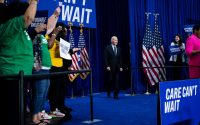Busloads of Migrants Keep Arriving in L.A. From Texas
Something many people have criticized as a political stunt playing out elsewhere in the country arrived in Southern California starting in mid-June.
A busload of 42 migrants from Texas landed in Los Angeles, dispatched with little warning by Texas authorities as part of a continuing protest against President Biden’s immigration policies.
Los Angeles officials condemned the move — Mayor Karen Bass said Gov. Greg Abbott of Texas was using the migrants “as pawns in his cheap political games” — but promised to help them find shelter and food, and to arrange for them to travel to meet loved ones.
The buses have kept coming. The fifth one arrived over the weekend, bringing the number of people dropped off in Los Angeles from the Lone Star State to 199, according to Bass’s office.
That’s in addition to at least 36 migrants who were flown to Sacramento last month, a plan that California officials believe was organized by Gov. Ron DeSantis of Florida in what appeared to be a similar attempt at making a political statement.
Some of the migrants who have been transported to California in recent weeks wanted to come, to reunite with relatives. But not all of them seemed entirely willing to head west, or were aware of exactly what was happening, according to Jorge-Mario Cabrera, a spokesman for the Coalition for Humane Immigrant Rights of Los Angeles, which has been helping the arriving migrants.
Cabrera said some passengers on the buses were as young as 6 months old, some were older adults and some had made the 30-hour-plus ride without any food.
“Sadly, the politics of a few are endangering many,” Cabrera told me.
The sending of migrants to blue states from red ones has become familiar in recent months.
Last fall, DeSantis directed two planeloads of South American migrants from San Antonio to Martha’s Vineyard, the Democratic-leaning island in Massachusetts. The same Florida program appears to have solicited asylum seekers in Texas and sent them without apparent notice to Sacramento in June. (This month, Democratic leaders in California and Texas urged the Justice Department to investigate the program.)
As of July 10, Texas had bused over 25,000 migrants to New York City, Denver, Philadelphia, Washington, D.C., and other cities, according to Abbott. “The busing mission provides critical relief to overwhelmed and overrun border towns,” he wrote on Twitter.
Brian Ferguson, a spokesman for Gov. Gavin Newsom’s Office of Emergency Services, said California didn’t have its own tally of how many migrants had recently been dispatched to the state, in large part because they were not coming through official channels and could be difficult to track.
He added that the arrivals were straining social safety-net programs that were needed to serve migrants who enter California through its own border with Mexico, as well as California residents who struggle with a lack of housing or mental health issues.
“It stresses these systems that are already spread so thin to provide vital services to vulnerable Californians,” Ferguson told me.
The migrants who arrive in Los Angeles are greeted by social service workers and nonprofit groups that administer Covid tests, provide clothing, food and showers and help them contact relatives who live in the region.
Most of the migrants are seeking asylum, with the largest proportion from Venezuela, Colombia, Haiti, Mexico, Guatemala, Honduras, El Salvador or China, Cabrera said. Most who have come to Los Angeles have relatives in the West, including Oakland, San Diego, Seattle or Reno, and hope to stay with them, he told me. A few lack such connections, though, and it’s unclear why they ended up on the bus, he said.
“Los Angeles has been preparing for this eventuality for many, many months, and that’s helped with minimizing the chaos that a sudden arrival of 40 migrants can mean,” Cabrera told me. “We can respond with dignity and respect to the needs of these migrants.”
Where we’re traveling
Today’s tip comes from Tim Veness, who recommends Helen Putnam Regional Park, in Sonoma County near Petaluma: “An easy uphill walk from either parking area to the top where one is rewarded with 360-degree views of the surrounding countryside, with many paths through old oaks and open fields.”
Tell us about your favorite places to visit in California. Email your suggestions to [email protected]. We’ll be sharing more in upcoming editions of the newsletter.
Tell us
What are the best books about California or the part of the state where you live? What fiction or nonfiction would you put on a Golden State reading list, and why?
Email us at [email protected] with your suggestions. Please include your name and the city where you live.
And before you go, some good news
The Ohlone people have lived in the Bay Area for thousands of years, but they and other California tribes have faced relocation, forced indoctrination and slaughter since Europeans arrived in the 1700s. Most of their land no longer belongs to them.
But a female-led trust is working to return East Bay land to Indigenous stewardship. And they just got their largest property yet — 43 acres in the hills above Oakland, The San Francisco Chronicle reports.
“It’s transformative,” said the trust’s creative director, Inés Ixierda.
Thanks for reading. I’ll be back tomorrow. — Soumya
P.S. Here’s today’s Mini Crossword.
Briana Scalia and Maia Coleman contributed to California Today. You can reach the team at [email protected].
Sign up here to get this newsletter in your inbox.


